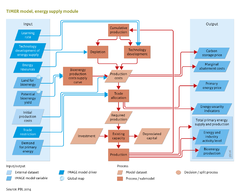Energy supply/Description: Difference between revisions
Jump to navigation
Jump to search
Oostenrijr (talk | contribs) No edit summary |
Oostenrijr (talk | contribs) No edit summary |
||
| Line 61: | Line 61: | ||
The structure of the biomass submodule is similar to that for fossil fuel supply, but with the following differences ([[Hoogwijk, 2004]]): | The structure of the biomass submodule is similar to that for fossil fuel supply, but with the following differences ([[Hoogwijk, 2004]]): | ||
* Depletion of bioenergy is not governed by cumulative production but by the degree to which available land is used for commercial energy crops. | * Depletion of bioenergy is not governed by cumulative production but by the degree to which available land is used for commercial energy crops. | ||
* The total amount of potentially available bioenergy is derived from bioenergy crop yields calculated on a 0.5x0.5 degree grid with the IMAGE [[Crops and grass|crop model]] for various land-use scenarios for the 21st century. Potential supply is restricted on the basis of a set of criteria, the most important of which is that bioenergy crops can only be on abandoned agricultural land and on part of the natural grassland. The costs of primary bioenergy crops (woody, maize and sugar cane) are calculated with a Cobb-Douglas economic growth model <ref><span style=" | * The total amount of potentially available bioenergy is derived from bioenergy crop yields calculated on a 0.5x0.5 degree grid with the IMAGE [[Crops and grass|crop model]] for various land-use scenarios for the 21st century. Potential supply is restricted on the basis of a set of criteria, the most important of which is that bioenergy crops can only be on abandoned agricultural land and on part of the natural grassland. The costs of primary bioenergy crops (woody, maize and sugar cane) are calculated with a Cobb-Douglas economic growth model <ref><span style="clear:both">The Cobb–Douglas production function is a particular functional form of the production function widely used to represent the technological relationship between the amounts of two or more inputs, particularly physical capital and labor, and the amount of output that can be produced by those inputs.</span></ref> using labour , land rent and capital costs as inputs. The land costs are based on average regional income levels per km<sup>2</sup>, which was found to be a reasonable proxy for regional differences in land rent costs. The production functions are calibrated to empirical data ([[Hoogwijk, 2004]]). | ||
* The model describes the conversion of biomass (including residues, in addition to wood crops, maize and sugar cane) to two generic secondary fuel types: bio-solid fuels used in the industry and power sectors; and liquid fuel used mostly in the transport sector. | * The model describes the conversion of biomass (including residues, in addition to wood crops, maize and sugar cane) to two generic secondary fuel types: bio-solid fuels used in the industry and power sectors; and liquid fuel used mostly in the transport sector. | ||
* The trade and allocation of biofuel production to regions is determined by optimisation. An optimal mix of bio-solid and bio-liquid fuel supply across regions is calculated, using the prices of the previous time step to calculate the demand. | * The trade and allocation of biofuel production to regions is determined by optimisation. An optimal mix of bio-solid and bio-liquid fuel supply across regions is calculated, using the prices of the previous time step to calculate the demand. | ||
Revision as of 15:43, 18 May 2018
Parts of Energy supply/Description
| Component is implemented in: |
|
| Related IMAGE components |
| Projects/Applications |
| Key publications |
| References |
Model description of Energy supply
